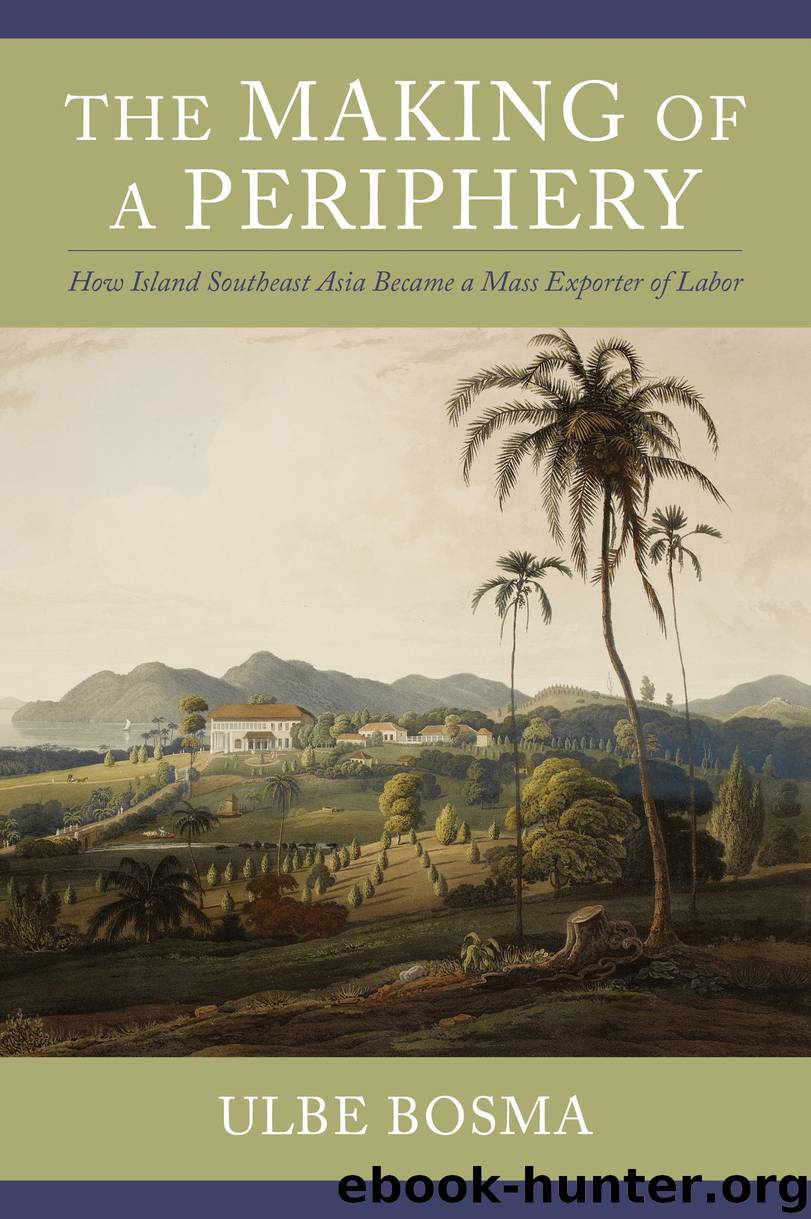The Making of a Periphery by Ulbe Bosma

Author:Ulbe Bosma
Language: eng
Format: epub
Publisher: Columbia University Press
CHAPTER SIX
Postcolonial Continuities in Plantations and Migrations
From the 1850s onward, an ongoing specialization in commodity production had linked Mainland and Island Southeast Asia to Japan, Southeast China, India, the United States, and Europe. Cheap transport had enabled the emergence of globalized markets for bulk products. Asian interdependence was embodied in labor flows from India and China, rice imports from mainland Southeast Asia, and plantation belts in Island Southeast Asia. Commodity chains rather than national policies forged trajectories of economic development, and these in turn shaped migration patterns. This interdependency unraveled during the Depression, a process that coalesced with the emergence of economic nationalism and nation building during decolonization but that had already started in the 1930s, as discussed in the previous chapter.
One of the most visible aspects of disintegration was the return migration of hundreds of thousands of Chinese and Tamils to their countries of origin. Between 1931 and 1947, the proportion of Indian migrants in the population of British Malaya shrunk by a third, and in postwar Malaysia their proportion in the plantation labor force would drop further.1 While the total proportion of the ethnic Chinese and Chinese newcomers in the population of Malaysia did not diminish, their position became increasingly insecure. One factor was the role of Chinese workers in the guerrilla uprising of the Communist Party in Malaysia that started in the late 1940s, in response to bad labor conditions on the plantations. To quell this uprising, the Chinese population was subjected to massive governmental resettlement schemes.2 Meanwhile, rising Malay nationalism asserted itself against Chinese and Tamil immigrants. The anti-Chinese attitude of the Malay political elite went so far that they expelled Singapore—where 75 percent of the population was ethnically Chinese—from the federal state of Malaysia in 1965.3 In this threatening atmosphere, hundreds of thousands of ethnic Chinese left Malaysia.4 In Indonesia, colonial times had left enough resentment to trigger the departure of about one hundred thousand Sino-Indonesians to China, many of whom were evacuated by the Chinese government in 1959. Ethnic Chinese also became victims of the 1965 massacres and of some anti-Chinese riots in their aftermath.5
The anti-Chinese and anti-immigrant sentiments revealed in a grim way the legacies of colonial plural societies and their economic dependence on commodity production by foreign companies. They were the dark side of the nationalist fervor that pushed government policies to nationalize their countries’ economies. British Malaya chose in this regard to invest in a strong ethnic Malay farmers’ class. Equally strong was the desire to catch up with the level of modernity of the former colonizers. Indonesian and Philippine politicians expected miracles from industrialization, to ward off the looming massive unemployment of a rapidly growing population. However, in their eagerness to follow this path, they sidestepped the immense structural problems in the countryside. This was particularly the case in Indonesia, where land scarcity and dilapidated irrigation works compounded the daunting challenge of feeding a rapidly growing population. The Indonesian government was under great pressure to increase food production, which had stagnated since 1940.
Download
This site does not store any files on its server. We only index and link to content provided by other sites. Please contact the content providers to delete copyright contents if any and email us, we'll remove relevant links or contents immediately.
Pale Blue Dot by Carl Sagan(4618)
The Rules Do Not Apply by Ariel Levy(4524)
Goodbye Paradise(3446)
Ogilvy on Advertising by David Ogilvy(3329)
Delivering Happiness by Tony Hsieh(3283)
Liar's Poker by Michael Lewis(3223)
Into Thin Air by Jon Krakauer(3131)
Purple Cow by Seth Godin(3069)
Rogue Trader by Leeson Nick(2825)
The Social Psychology of Inequality by Unknown(2766)
The Airbnb Story by Leigh Gallagher(2701)
4 - Harry Potter and the Goblet of Fire by J.K. Rowling(2530)
The Mind Map Book by Tony Buzan(2415)
Bossypants by Tina Fey(2373)
All the President's Men by Carl Bernstein & Bob Woodward(2263)
Claridge's: The Cookbook by Nail Martyn & Erickson Meredith(2257)
Six Billion Shoppers by Porter Erisman(2227)
Master of the Game by Sidney Sheldon(2182)
Alibaba by Duncan Clark(1979)
